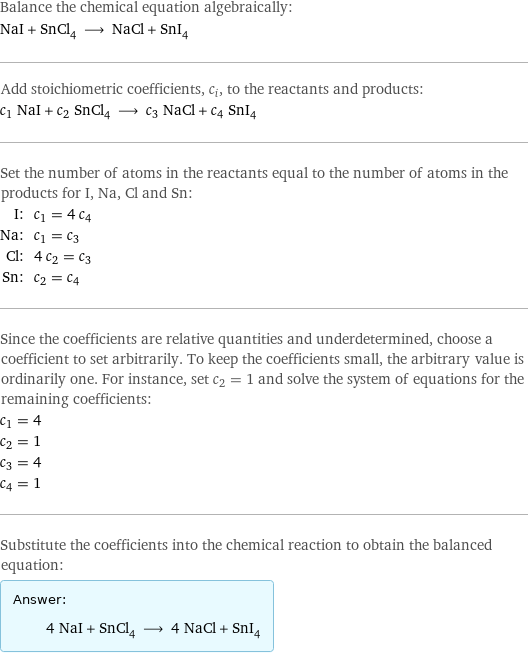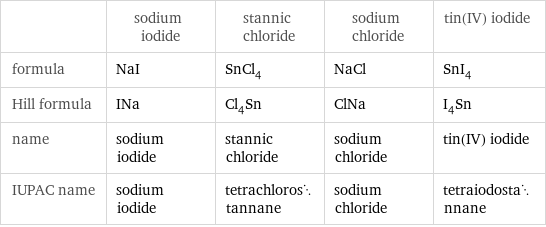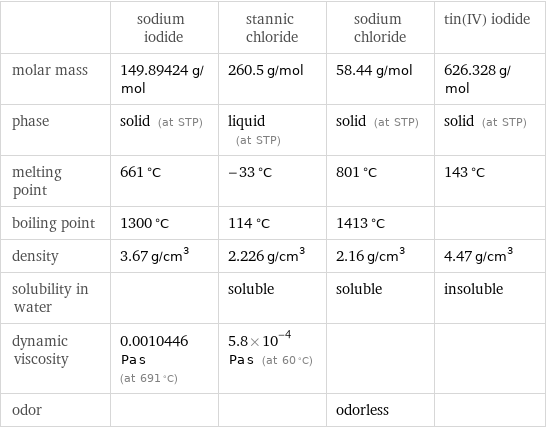Input interpretation

NaI sodium iodide + SnCl_4 stannic chloride ⟶ NaCl sodium chloride + SnI_4 tin(IV) iodide
Balanced equation

Balance the chemical equation algebraically: NaI + SnCl_4 ⟶ NaCl + SnI_4 Add stoichiometric coefficients, c_i, to the reactants and products: c_1 NaI + c_2 SnCl_4 ⟶ c_3 NaCl + c_4 SnI_4 Set the number of atoms in the reactants equal to the number of atoms in the products for I, Na, Cl and Sn: I: | c_1 = 4 c_4 Na: | c_1 = c_3 Cl: | 4 c_2 = c_3 Sn: | c_2 = c_4 Since the coefficients are relative quantities and underdetermined, choose a coefficient to set arbitrarily. To keep the coefficients small, the arbitrary value is ordinarily one. For instance, set c_2 = 1 and solve the system of equations for the remaining coefficients: c_1 = 4 c_2 = 1 c_3 = 4 c_4 = 1 Substitute the coefficients into the chemical reaction to obtain the balanced equation: Answer: | | 4 NaI + SnCl_4 ⟶ 4 NaCl + SnI_4
Structures

+ ⟶ +
Names

sodium iodide + stannic chloride ⟶ sodium chloride + tin(IV) iodide
Equilibrium constant
![Construct the equilibrium constant, K, expression for: NaI + SnCl_4 ⟶ NaCl + SnI_4 Plan: • Balance the chemical equation. • Determine the stoichiometric numbers. • Assemble the activity expression for each chemical species. • Use the activity expressions to build the equilibrium constant expression. Write the balanced chemical equation: 4 NaI + SnCl_4 ⟶ 4 NaCl + SnI_4 Assign stoichiometric numbers, ν_i, using the stoichiometric coefficients, c_i, from the balanced chemical equation in the following manner: ν_i = -c_i for reactants and ν_i = c_i for products: chemical species | c_i | ν_i NaI | 4 | -4 SnCl_4 | 1 | -1 NaCl | 4 | 4 SnI_4 | 1 | 1 Assemble the activity expressions accounting for the state of matter and ν_i: chemical species | c_i | ν_i | activity expression NaI | 4 | -4 | ([NaI])^(-4) SnCl_4 | 1 | -1 | ([SnCl4])^(-1) NaCl | 4 | 4 | ([NaCl])^4 SnI_4 | 1 | 1 | [SnI4] The equilibrium constant symbol in the concentration basis is: K_c Mulitply the activity expressions to arrive at the K_c expression: Answer: | | K_c = ([NaI])^(-4) ([SnCl4])^(-1) ([NaCl])^4 [SnI4] = (([NaCl])^4 [SnI4])/(([NaI])^4 [SnCl4])](../image_source/ac61c8cc5b3e21ee423ec7b1ea47ee36.png)
Construct the equilibrium constant, K, expression for: NaI + SnCl_4 ⟶ NaCl + SnI_4 Plan: • Balance the chemical equation. • Determine the stoichiometric numbers. • Assemble the activity expression for each chemical species. • Use the activity expressions to build the equilibrium constant expression. Write the balanced chemical equation: 4 NaI + SnCl_4 ⟶ 4 NaCl + SnI_4 Assign stoichiometric numbers, ν_i, using the stoichiometric coefficients, c_i, from the balanced chemical equation in the following manner: ν_i = -c_i for reactants and ν_i = c_i for products: chemical species | c_i | ν_i NaI | 4 | -4 SnCl_4 | 1 | -1 NaCl | 4 | 4 SnI_4 | 1 | 1 Assemble the activity expressions accounting for the state of matter and ν_i: chemical species | c_i | ν_i | activity expression NaI | 4 | -4 | ([NaI])^(-4) SnCl_4 | 1 | -1 | ([SnCl4])^(-1) NaCl | 4 | 4 | ([NaCl])^4 SnI_4 | 1 | 1 | [SnI4] The equilibrium constant symbol in the concentration basis is: K_c Mulitply the activity expressions to arrive at the K_c expression: Answer: | | K_c = ([NaI])^(-4) ([SnCl4])^(-1) ([NaCl])^4 [SnI4] = (([NaCl])^4 [SnI4])/(([NaI])^4 [SnCl4])
Rate of reaction
![Construct the rate of reaction expression for: NaI + SnCl_4 ⟶ NaCl + SnI_4 Plan: • Balance the chemical equation. • Determine the stoichiometric numbers. • Assemble the rate term for each chemical species. • Write the rate of reaction expression. Write the balanced chemical equation: 4 NaI + SnCl_4 ⟶ 4 NaCl + SnI_4 Assign stoichiometric numbers, ν_i, using the stoichiometric coefficients, c_i, from the balanced chemical equation in the following manner: ν_i = -c_i for reactants and ν_i = c_i for products: chemical species | c_i | ν_i NaI | 4 | -4 SnCl_4 | 1 | -1 NaCl | 4 | 4 SnI_4 | 1 | 1 The rate term for each chemical species, B_i, is 1/ν_i(Δ[B_i])/(Δt) where [B_i] is the amount concentration and t is time: chemical species | c_i | ν_i | rate term NaI | 4 | -4 | -1/4 (Δ[NaI])/(Δt) SnCl_4 | 1 | -1 | -(Δ[SnCl4])/(Δt) NaCl | 4 | 4 | 1/4 (Δ[NaCl])/(Δt) SnI_4 | 1 | 1 | (Δ[SnI4])/(Δt) (for infinitesimal rate of change, replace Δ with d) Set the rate terms equal to each other to arrive at the rate expression: Answer: | | rate = -1/4 (Δ[NaI])/(Δt) = -(Δ[SnCl4])/(Δt) = 1/4 (Δ[NaCl])/(Δt) = (Δ[SnI4])/(Δt) (assuming constant volume and no accumulation of intermediates or side products)](../image_source/8c4feac31803621be7c4663ef924d893.png)
Construct the rate of reaction expression for: NaI + SnCl_4 ⟶ NaCl + SnI_4 Plan: • Balance the chemical equation. • Determine the stoichiometric numbers. • Assemble the rate term for each chemical species. • Write the rate of reaction expression. Write the balanced chemical equation: 4 NaI + SnCl_4 ⟶ 4 NaCl + SnI_4 Assign stoichiometric numbers, ν_i, using the stoichiometric coefficients, c_i, from the balanced chemical equation in the following manner: ν_i = -c_i for reactants and ν_i = c_i for products: chemical species | c_i | ν_i NaI | 4 | -4 SnCl_4 | 1 | -1 NaCl | 4 | 4 SnI_4 | 1 | 1 The rate term for each chemical species, B_i, is 1/ν_i(Δ[B_i])/(Δt) where [B_i] is the amount concentration and t is time: chemical species | c_i | ν_i | rate term NaI | 4 | -4 | -1/4 (Δ[NaI])/(Δt) SnCl_4 | 1 | -1 | -(Δ[SnCl4])/(Δt) NaCl | 4 | 4 | 1/4 (Δ[NaCl])/(Δt) SnI_4 | 1 | 1 | (Δ[SnI4])/(Δt) (for infinitesimal rate of change, replace Δ with d) Set the rate terms equal to each other to arrive at the rate expression: Answer: | | rate = -1/4 (Δ[NaI])/(Δt) = -(Δ[SnCl4])/(Δt) = 1/4 (Δ[NaCl])/(Δt) = (Δ[SnI4])/(Δt) (assuming constant volume and no accumulation of intermediates or side products)
Chemical names and formulas

| sodium iodide | stannic chloride | sodium chloride | tin(IV) iodide formula | NaI | SnCl_4 | NaCl | SnI_4 Hill formula | INa | Cl_4Sn | ClNa | I_4Sn name | sodium iodide | stannic chloride | sodium chloride | tin(IV) iodide IUPAC name | sodium iodide | tetrachlorostannane | sodium chloride | tetraiodostannane
Substance properties

| sodium iodide | stannic chloride | sodium chloride | tin(IV) iodide molar mass | 149.89424 g/mol | 260.5 g/mol | 58.44 g/mol | 626.328 g/mol phase | solid (at STP) | liquid (at STP) | solid (at STP) | solid (at STP) melting point | 661 °C | -33 °C | 801 °C | 143 °C boiling point | 1300 °C | 114 °C | 1413 °C | density | 3.67 g/cm^3 | 2.226 g/cm^3 | 2.16 g/cm^3 | 4.47 g/cm^3 solubility in water | | soluble | soluble | insoluble dynamic viscosity | 0.0010446 Pa s (at 691 °C) | 5.8×10^-4 Pa s (at 60 °C) | | odor | | | odorless |
Units
